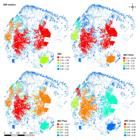Abstract
Human activity has prompted a rapid decline in the forested areas of the Amazon, resulting in an increase in the number of isolated forest fragments. Belém is the smallest and most deforested area of endemism in the biome. Its high level of degradation translates into great biodiversity vulnerability and the need for urgent measures to address these changes. The aim of this research was to analyze connectivity among the Belém’s remaining forest fragments and to classify them according to their importance for population dispersal. We used morphological spatial pattern analysis to characterize landscape structure and the integral index of connectivity to defi ne the importance of forest fragments. From a structural perspective, 55.28% of the forested area was classifi ed as core, 16.88% as edge. From a functional perspective, few fragments were classifi ed as highly important. In general, larger fragments were more important for connectivity. The protected areas seem to not have considered the forest connectivity in their planning, although the designation of priority areas has valued this variable. This study provides an important theoretical outline for considering connectivity in the planning phase and represents a contribution to more detailed research on how to maintain biodiversity in the Belém Area of Endemism.
Key words
Amazon; connectivity; fragmentation; protected areas

 Thumbnail
Thumbnail
 Thumbnail
Thumbnail
 Thumbnail
Thumbnail
 Thumbnail
Thumbnail
 Thumbnail
Thumbnail
 Thumbnail
Thumbnail
 Thumbnail
Thumbnail






